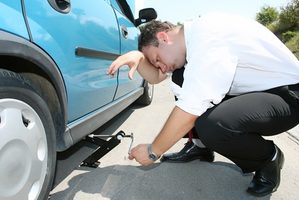Everyone who drives experiences an occasional flat tire. Flat tires are more than just a nuisance. When they occur at night, on a roadway with no shoulder, during inclement weather or in a dead zone for your cell phone, a flat tire presents a threat to safety. Flats are impossible to prevent, but awareness of the causes and a few tire safety tips help to minimize the frequency of their occurrences.
Valve Stem
-
Valve stem problems that cause air leaks cause tires to go flat. Air leaks develop as the result of corrosion or damage corrupting the seal between the wheel and the stem. Loose valve stems or uncapped stems clogged with dirt cause tires to lose air.
Road Hazards
-
Blowouts ruin a tire and happen unexpectedly when hitting a pothole, a curb or an unexpected object on the road. A small puncture in tires caused by sharp objects, such as screws, nails or broken glass, causes the tire to develop slow leaks.
Unexpected Damage
-
Continually hitting curbs when making turns or parking damages the wheel. Even a small dent in the wheel breaks the seal between the tire and the rim and causes a flat or slow leak. Rubbing tires up against the curb when you park damages the sidewall, increasing your risk for a blowout.
Vandalism
-
Vandals cause flat tires by letting the air out of them. Although this is an annoyance, it is a lot less costly than having to repair or replace a tire. A can of tire sealer in your car comes in handy in situations like this.
Miscellaneous Causes
-
A manufacturing defect in a tire or rim prevents it from forming a proper seal and causes a slow leak. Under-inflated tires lead to flats or blowouts.
Protect Your Tires
-
For tire safety, Goodwrench Service suggests using the right tires for your vehicle. Check tire pressure monthly, replace worn tires and have your alignment checked if your tires show signs of unusual wear. If you become aware of any vibration not related to the road surface, consider having your wheels balanced. Rotating tires on a regular basis protects them against uneven tread wear.
Safety Tires
-
Three types of tires allow you to continue driving after a puncture without your tire going flat, according to Tire Rack. Run-flat tires have stiff, self-supporting sidewalls. These tires support the weight of your vehicle after a blowout, allowing you to drive without air for approximately 50 to 100 miles at 55 mph. This feature allows you enough time to get to a mechanic. Self-sealing tires contain a puncture sealant that permanently seals punctures from nails, bolts and screws. In the event of a flat, auxiliary support systems allow the tire’s tread to rest on a ring attached to the wheel. This allows the wheel to provide support for the vehicle instead of the tire.
